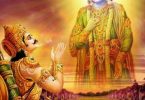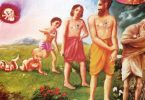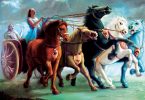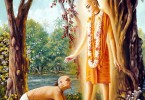Question: Where is the existence of Radha verified in scripture? How to respond to this question, when asked by those who are unfamiliar with Radha Krsna worship?
Answer by Romapada Swami:
Baladeva Vidyabhusan’s Govinda Bhasya – commentary on Vedanta Sutra
|| 2.3.45 ||
In the Puruña-bodhiné Upaniñad it is said that Lord Kåñëa appears with all His transcendental potencies, headed by Goddess Rädhä.
|| 3.3.42 ||
When the supreme entity endowed with his svarüpa-çakti called parä, established in çruti and småti, manifests with himself in the predominant position, it is called Supreme Lord. When he is manifest with parä-çakti predominant, it is called his quality (dharma). Parä manifests as dharma in the form of knowledge, joy, compassion, majesty, sweetness. As sound, she takes the form of the name. As the earth, she is the form of the dhäma. Forms of Çré like Rädhä are all called parä since they are all the jewel of youthfulness composed of saàvit (consciousness), endowed with the essence of hlädiné (bliss). Though Çré is non-different from him, her desire for him is accomplished because of the appearance of difference of äsraya and viñaya produced through the action of distinction, caused by viçeña. Her forms as quality etc. are not later creations but eternally accomplished. There is no fault at all in this manifestation. Therefore the devotees should meditate on the supreme Lord with Çré, his consort.
NOTE: What follows is an alternative translation of the same section’s commentary:
Different from His spiritual potency (parä çakti) is the potency of the Lord’s form (svarüpa-çakti). The Çruti-çästras and other scriptures explain that through the svarüpa-çakti the Supreme Lord manifests as the best of males, and through the parä çakti the Lord manifests His various transcendental qualities. It is through the parä çakti that the Lord manifests His knowledge, bliss, mercy, opulence, power, sweetness, and other qualities. It is also through the parä çakti that the Vedic scriptures are manifested. In the same way is manifested the earth and other places. manifesting as the Lord’s pleasure potency (hlädiné çakti), the parä çakti appears as Çré Rädhä, the jewel of teenage girls. Although the Lord and His parä çakti are not different, still, for enjoying different pastimes, They are manifested as different. In this way the Lord’s desires are perfectly and completely fulfilled. These manifestations of the parä çakti, beginning with the manifestation of the Lord’s qualities, are not manifested only recently. They are beginningless and eternal. They will never cease to exist. Therefore the devotees should meditate on the Supreme Personality of Godhead as accompanied by the goddess of fortune.
~~~
In the second portion of Gopäla-täpané Upaniñad it is said that Durväsä gave up his bad tendency for anger completely and became pleased and ate Radha’s cooking with relish. Thus her cooking is always full of sweetness.
~~~
Translation from Cc Adi 4.83 – quoted from Båhad-gautaméya-tantra
devī kṛṣṇa-mayī proktā
rādhikā para-devatā
sarva-lakṣmī-mayī sarva-
kāntiḥ sammohinī parā
devī — who shines brilliantly; kṛṣṇa-mayī — nondifferent from Lord Kṛṣṇa; proktā — called; rādhikā — Śrīmatī Rādhārāṇī; para-devatā — most worshipable; sarva-lakṣmī-mayī — presiding over all the goddesses of fortune; sarva-kāntiḥ — in whom all splendor exists; sammohinī — whose character completely bewilders Lord Kṛṣṇa; parā — the superior energy.
“The transcendental goddess Śrīmatī Rādhārāṇī is the direct counterpart of Lord Śrī Kṛṣṇa. She is the central figure for all the goddesses of fortune. She possesses all the attractiveness to attract the all-attractive Personality of Godhead. She is the primeval internal potency of the Lord.”
~~~
Also: From Kåñna Sandarbha 189 by Jéva Goswämé ~
1. In Båhad-gautaméya-tantra, Kåñna speaks to Balaräma:
sattvaà tattvaà paratvaà ca tattva-trayam ahaà kila | tri-tattva-rüpiëé säpi rädhikä mama vallabhä || prakåteù para evähaà säpi mac-chakti-rüpiëé | sättvikaà rüpam ästhäya pürëo’haà
brahma-cit-paraù || brahmaëä prärthitaù samyak sambhavämi yuge yuge | tayä särdhaà tvayä särdhaà näçäya devatä-druhäm ||
“I am the three principles: sattva (cause), tattva (effect) and paratva (spiritual energy). The form of these three is Rädhikä my consort. I am beyond prakåti and she is my çakti. Situated in sattva I am and complete, engaged in the consciousness of Brahman. Requested by Brahmä I appear in the world in every yuga with Rädhä for destroying the enemies of the devatäs.
2. devé kåñëa-mayé proktä rädhikä para-devatä | sarva-lakñmé-mayé sarva-käntiù saàmohiné parä ||
Rädhä, non-different from Kåñëa, is the supreme devatä. All Lakñmés reside within her. She has all beauty, bewilders everyone and is supreme. Gautaméya-tantra
3. Åg-veda-pariçiñöa says rädhayä mädhavo devo mädhavenaiva rädhikä | vibhräjante janeñvä:
Rädhä shines with Kåñëa and Kåñëa shines with Rädhä among the people, everywhere.
~~~
Gändharvä mentioned in Gopäla-täpané Upaniñad also refers to Rädhä since she is described as the principal gopé.
Atharva Veda, Gopäla-täpané Up, regarding Govinda: “The dark complexioned, yellow-robed, two-armed Govindadeva, His head adorned with a peacock comb, holds a flute and stick in His hands. … In Gokula, within Mathurä-maëòala, is Våndävana, where Govinda stands in the center







